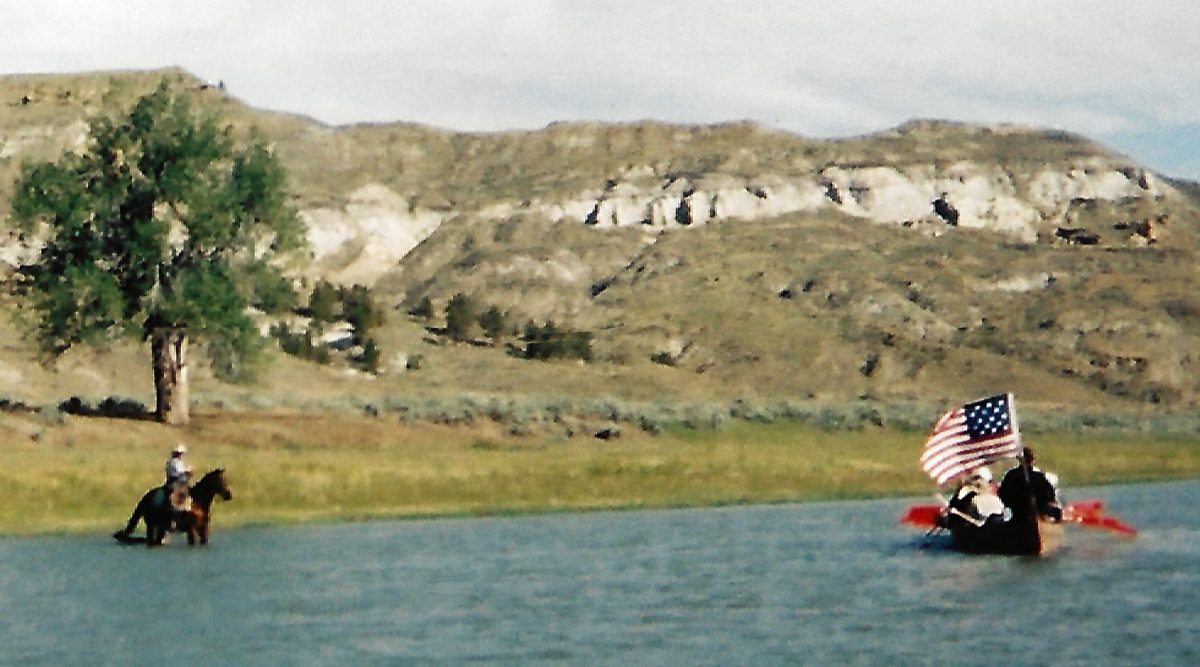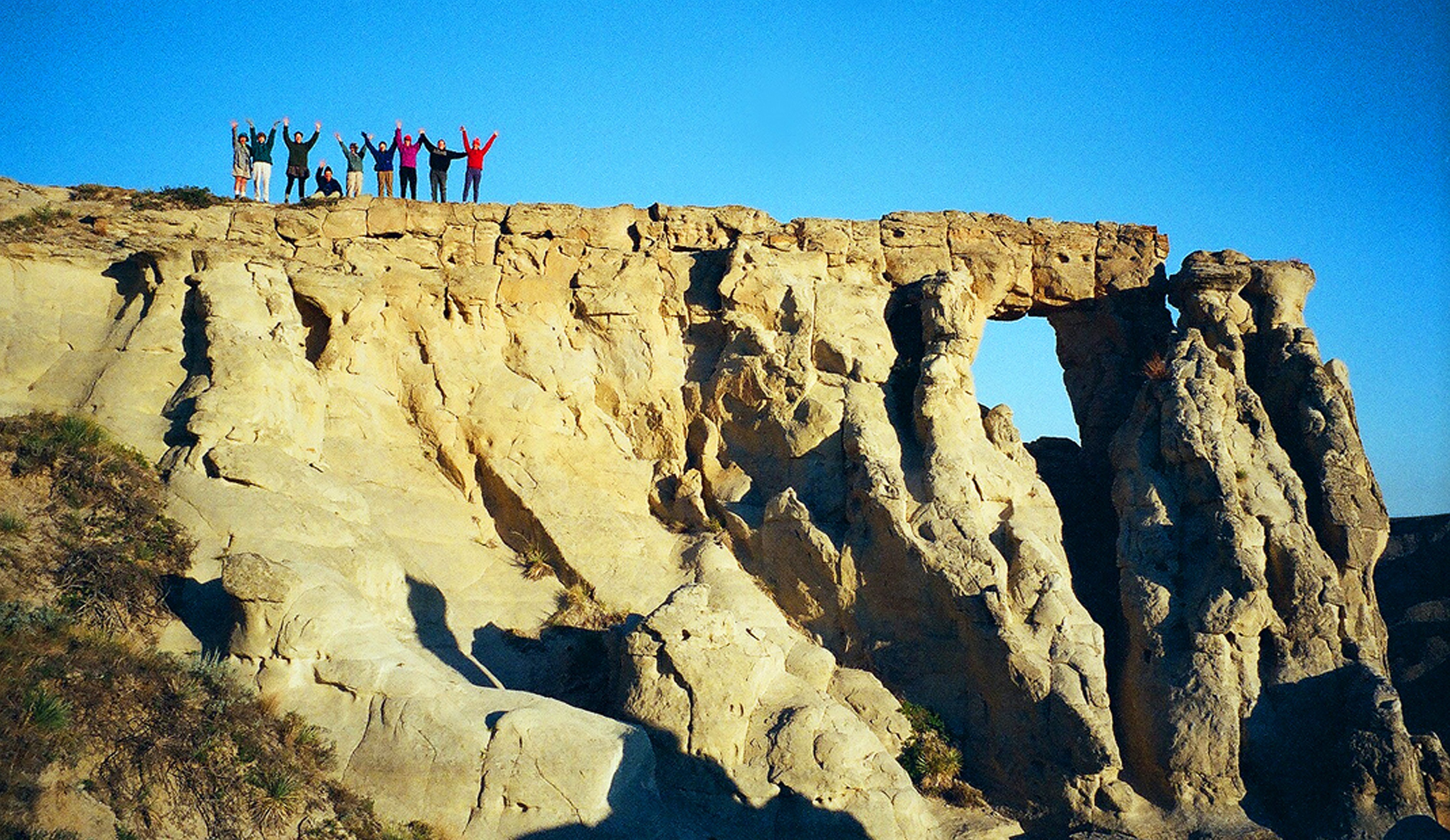AdventureWomen guest, Marian Hammond, has been on 10 AdventureWomen trips over the years. Marion has written this wonderful and thought-provoking piece with excepts from her journal about being on AdventureWomen’s first Lewis & Clark Canoeing vacation in Montana in September of 2001, on a remote stretch of the Missouri River. Read her recollections and flashbacks as the 9/11 attacks in New York unfolded, where her husband was visiting at the time.
“HELLO? HELLO, CENTRAL?”*
Further Excerpts from Marian Hammond’s Journal
Even in the wilderness, we remained linked to our outside worlds
*The title hearkens back to the days of crank telephones and the challenges of long-distance communication through a series of local central operators.
Julie and I unzipped our tent flap at 7:30 a.m., thinking we had badly overslept. Welcome surprise! Tim and JoJo [the guides] were just bringing tea and coffee to all of our tents. Tim apologized for being late. “It’s so cold and windy that nobody wanted to get up, not even us,” he said. Actually, I thought the tea and coffee appeared at just the right time.
By nine o’clock, our guides had another wonderful river breakfast ready for us: grilled sausages, French toast and cantaloupe. The morning walk/hike had been shelved. Since this was to be a 17-mile paddle day against strong headwinds, we needed to get going. The day was partly sunny. Temps by my thermometer would range from the low 50s to low 70s, but it felt colder because of the wind chill and occasional cloud cover.
Today was Day 5 of our AdventureWomen’s canoeing trip on the Lewis & Clark Trail in the remote Montana wilderness. Days 3 and 4 were described in my preceding essay “Answering Time’s Roll Call.” The Missouri River, narrow at the beginning of the trip, had now widened to one-half mile or more, and because of long drought periods it was unusually low. In fact, the river was so low that we embarrassed ourselves by getting our canoe stuck in the middle of it. We were seeing islands and riverbanks that probably had not been visible to Lewis and Clark or as recently as five to ten years ago. The Missouri’s muddy bottom, however, certainly fit descriptions in the L&C journals. When we disembarked at shore areas where there was no stony bottom, we sank up to our ankles in sticky mud. It was all we could do to stay balanced and to keep our sandals on our feet.
We were paddling through geology changing from the White Cliffs to the badlands of the Missouri River Breaks, and we were beginning to see more signs of civilization like abandoned homesteads, working ranches and irrigation equipment. At about 11:30, we noticed a cowboy riding his horse along a path paralleling the river. A black dog raced ahead of him, and far behind came a second dog. The cowboy stopped and asked us if we had passed a white calf “back there.” “Noooooo!” we yelled across the water, and he continued his search. Ten or fifteen minutes later, we watched the parade coming back with a new addition: the jogging calf.
We hollered at him again. He acknowledged our greeting, slowed and rode his horse into the water. His words to the front canoe floated back to us and we heard them all too clearly: Yesterday…Airplanes…Terrorists…New York Trade Center…Pentagon…Pennsylvania crash…Boston… American and United Airlines…Airports closed… And then he rode on.
Silence. Twenty-four hours ago we were joyously climbing to Hole in the Wall and exploring the river. It had been so peaceful here, so quiet.
Something inspiring happened then. We looked up and saw a bald eagle circling so low overhead that we could clearly see the curve of his beak and his white neck and tail feathers tapering into his darker body feathers. He soared over us with his wings spread so wide we could see the blue of the sky behind them and through them. He flew off toward the mesas to catch the thermals and then soared back to us again. Our national bird. Maybe he came to give us hope.
We soon reached Judith Landing and headed directly for the attendant who stayed there in a trailer during the tourist season. The attendant confirmed the facts we had heard and offered his phone to anyone who could use prepaid calling cards. One generous woman gave me some of her calling card minutes so I could leave a message on my son’s answering machine.
My own mind and heart were racing in starts and stops as I refocused on the outside world. J., my husband and inspiration for the title of this piece, was in New York. I knew his general plans but not his specific logistics. Where had he been on that morning of Tuesday, September 11? Waves of shock and fear. Had J. been caught in that havoc? His hotel was located in midtown, and he usually didn’t leave his room until about 10:30. The attacks began at 8:45. Wouldn’t his appointments have been cancelled? J.’s very resourceful. Maybe he had found a way out, and maybe he was even home. I dug down deep. What did my inner self have to tell me? It seemed that J. was safe. But was this hope? Or was this true? I began to trust my gut feelings, so I could handle the rest of the trip and develop options for getting home.
We wandered, sometimes in small groups and sometimes alone, as we each in our own way began to process the implications of this nightmare for our individual circumstances. We cried. I kept running to the bathroom, and judging from the line, the physiology of many of the other women was reacting the same way. Sometimes we were almost sorry we had heard the news before the end of the trip. But that didn’t seem right either, because we realized that even in the wilderness, we remained linked to our outside worlds.
The guides kept our routine going by spreading a marvelous lunch of bagels, smoked salmon and grilled salmon leftover from Sunday dinner: cream cheeses, capers, olives, tomatoes, tostados, other accompaniments and Oreo cookies. Being hungry seemed odd in the face of this national tragedy.
After lunch Tim read us more entries from the Lewis and Clark journals, and then we put back into the river to paddle about four more hours. The wind blew stronger, the sun went behind the clouds, and it got chillier and chillier. Mid-afternoon we pulled off to investigate an old homesteading site preserved by the Montana Commission of Park Services. Someone, probably in the early 1900s, had built a round sod house into a dirt mound atop a small ridge with a gorgeous view of the river and opposite shore. Half a field away we found more ruins: lengths of wood apparently cut for siding, round nails and a whole stove lying among other artifacts. As Ella Mae observed, “These were someone’s dreams.”
“By 5:00, we reached the inviting cottonwood grove where our guides had set up camp. We spent the late afternoon “down” time in different ways. I made journal entries. And then I found a quiet spot along the river where I could meditate, but my thoughts and feelings were so active that I was unable to achieve the peace I usually do.”
We savored an Italian dinner after dark in the glow of our headlamps. Our talented guides/chefs offered up lasagnas, salad, warm garlic bread and pineapple upside-down cake. The sounds of the wind had become almost eerie. By tacit agreement, we scratched the evening campfire. Several went to bed early. Julie and I felt wakeful, so we traded funny stories from previous AdventureWomen trips. We laughed and laughed. It was comic relief.
Sometime during the night, the wind finally died down. We spent our last morning, Day 6, paddling leisurely and exploring the old Hagadone Homestead. Dave read to us about its history. We took many, many photos, and, given the circumstances, enjoyed ourselves.
 At about 1:30 p.m., we reached Stafford McClellan Ferry to board our bus for the 140-mile trip back to Great Falls. It was then I received a surprise that made me realize I had been carrying a much greater emotional load than I had known. As I climbed the steps into the bus, Linda leaned forward from the front seat and said “Marian, the driver has a letter for you and it’s good news. Your husband is all right.” I lost every sense of control I had constructed for myself. “What? Where?” The driver pointed to a piece of paper. I picked it up and read and reread and reread. It was one of the most important communications I have ever received.
At about 1:30 p.m., we reached Stafford McClellan Ferry to board our bus for the 140-mile trip back to Great Falls. It was then I received a surprise that made me realize I had been carrying a much greater emotional load than I had known. As I climbed the steps into the bus, Linda leaned forward from the front seat and said “Marian, the driver has a letter for you and it’s good news. Your husband is all right.” I lost every sense of control I had constructed for myself. “What? Where?” The driver pointed to a piece of paper. I picked it up and read and reread and reread. It was one of the most important communications I have ever received.
Before leaving home, I had given my AdventureWomen contact information to J. J. had carried it with him to New York, and on the morning of 9/11 he had initiated a communication chain to tell me he was safe. Since cell phones were not working, he had waited in line to use a payphone in his hotel lobby to call Cherie in the AdventureWomen office; Cherie had called ROW, Inc. (River Odysseys West, our outfitter); Laurie, ROW secretary, had written a letter and faxed it to the bus company in Great Falls; the bus company had given the fax to our driver, and our driver had given it to me. All those links held. I will always be grateful to each of those local centrals for being available and passing that message on to me accurately and intact.
As soon as we returned to our Inn in Great Falls, we rushed for our phones and reconnected with our families and friends. Some of us had to stay in Great Falls a day or two longer than we had planned, but that seemed a small inconvenience in the general scheme of things.
Back home, someone asked me how I had been able to get any sort of pleasure from the trip after I heard about the attacks. I had thought about that, too. I decided that although our shock, anger and fear were close to the surface, we felt numb. I think we all tried to use that time in such a beautiful setting with such a congenial group to build a reservoir of memories and energy that would help us manage our respective futures.





